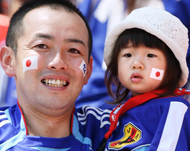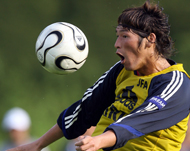Cup fever grips Brazil’s little Japan
An elderly Japanese man takes the microphone and begins strangling Bon Jovi’s “Living on a Prayer’.

It’s midnight and the karaoke bar, brightly-coloured and decorated with kitsch exotic fish aquariums is packed with Japanese youth eating sushi.
Except the language being spoken isn’t from the Far East. It’s Portuguese, and this is Brazil.
The Liberdade neighbourhood of S?o Paulo is the epicentre of the largest Japanese population outside of Japan.
When Brazil went through it’s coffee boom in the early part of the 19th century, the Japanese Imperial Government agreed a large-scale migration to help on the plantations. Their descendants are estimated to number one and a half million.
 |
|
S?o Paulo: home to the largest |
So when Brazil takes on Japan in their last group match on June 22, loyalties will be tested to the maximum.
Most third generation Japanese don’t speak their native tongue and have never visited their mother-country. but the elders keep many traditions.
As a testimony to this double-identity which marks the generations and the neighbourhood, street names are in both languages.
Crossed cultures
It’s one of the world’s oddest cross-cultural mixes if stereotypes are to be believed – the quiet, private and reserved Japanese versus the loud, chatty, and famously flamboyant Brazilians.
|
“I tell them to take risks and they ask ‘what if I get it wrong?’. Try again!” Zico |
And if there’s one man who can bear witness to this it’s Brazilian football legend Zico, one of the greatest players never to win a world cup, and nowadays coach of the Japanese national team.
“When I took over, they didn’t talk to each other,” Zico recently told Brazilian football magazine, Placar.
“One time, a friend of mine asked Nakata to introduce him to [team-mate] Okubo and he said he didn’t know him! It took me almost a year to integrate them. Their wives say they adore me, saying that before they didn’t go anywhere and today they take part in meetings and parties.”
In the interview he described how he brought a Brazilian cultural revolution to the Japanese side.
Initiative
 |
|
Japanese fans are hoping to give |
“They needed to learn to have initiative. Because the Japanese are like this. I tell them to take risks and they ask ‘what if I get it wrong?’. Try again! They are afraid of being punished. I changed this.”
This revitalized Japan went on to win 11 of their 12 qualifying games, losing only to Iran away from home.
On top of this, as a warning for Brazil, they came within an ace of knocking them out of last year’s Confederations’ Cup in Germany, drawing 2:2.
Shunsuke Nakamura, Japan’s star player who wears the club shirt of Italian side Reggina, scored a stunning 30-metre strike and Masashi Oguro equalised two minutes from time.
In extra-time it needed a point-blank save from Oguro by Marcos in the Brazilian goal to save red-faces and give Brazil the draw they needed to go through to the semi-finals.
“I adopted a suicide tactic because Brazil were not prepared for a team who attack,” said Zico, the eternal hero of Flamengo, Brazil’s most-supported club based in Rio de Janeiro.
“I know I risked getting a good beating. But I don’t have fear.”
Japan’s rise
 |
|
The Japanese team have been |
The Japanese championship, the J-League, was created in 1993. In their first world cup Japan didn’t get off to an auspicious start, losing all their games and even going down to Jamaica.
In 2002 they were a revelation, albeit still overshadowed by co-hosts South Korea led by Gus Hiddink who made it to the semi-finals.
Hiddink is now in charge of another minnow, Australia – who inflicted a 3-1 shocker on Japan in their opening match in Kaiserslautern on June 12.
Adding to the mood of festivites in Liberdade is the coincidence of the World Cup with celebrations marking the anniversary of the arrival of the first immigrant ‘nikkies’, as the Brazilian-Japanese are known, on the ship Kasato Muro in 1908.
“June is already a special time for us in Brazil but this time it will spectacular,” says Liberdade resident Regina Kyamoto.
Strong links
“I am Brazilian, I will be supporting my country but I have many relatives in Japan who will be sad when they lose, ” she laughs.
Japan, for it’s part, has a community of around 300,000 Brazilians and as proof of the strength of the links between the two nations, Japanese Premier Junichiro Koizumi visited Liberdade, which means ‘freedom’ in Portuguese, in 2004.
Koizumi, with his mane of long grey hair, epitomises a relaxation in the behaviour and appearance of the Japanese on the world stage.
But when it comes to their footballers, Zico is not a fan.
“The ones who play in Europe are like popstars. Each one has their hair coloured, their flash watches. They know I don’t like this type of long-haired player. But I don’t reprimand them,” he says.
“If they want to play with a parrot on their heads, and they play well, the problem is theirs.”